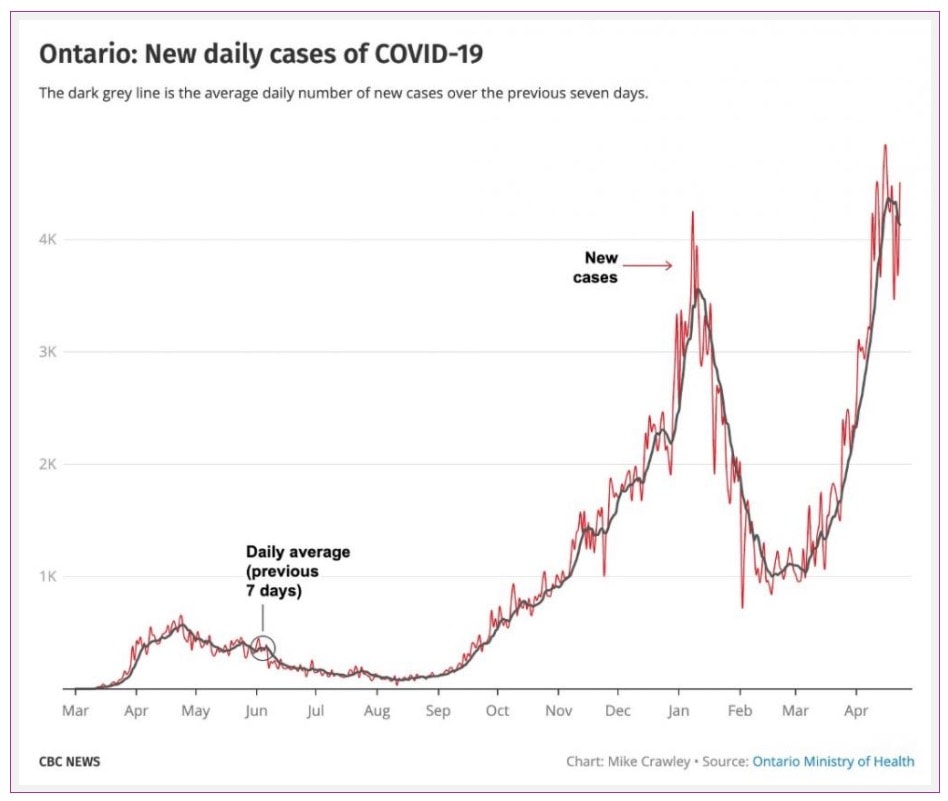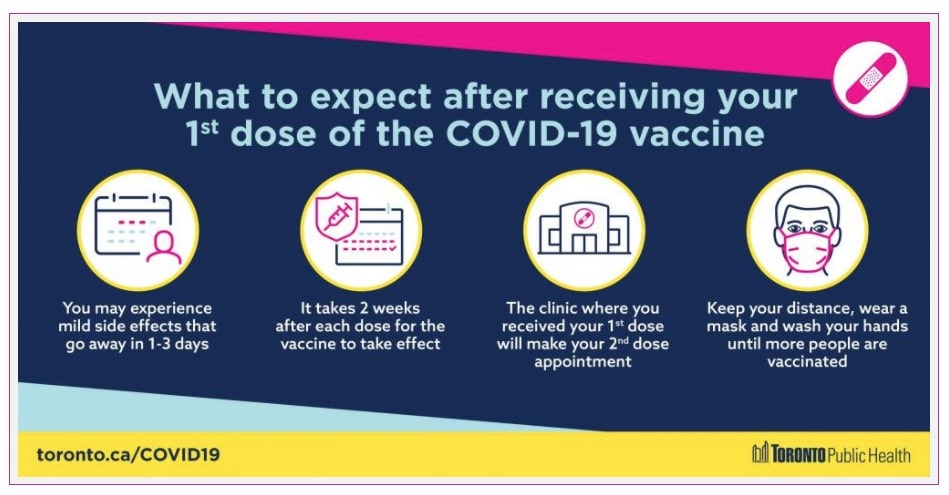Hello friends!
Welcome back!
I hope you and your families are healthy and safe and enjoyed a lovely weekend!
Now that it is getting nice outside, and we can have more space and freedom to explore in the warmth, I feel somewhat better.
As we do each week, we will review the bad news and the good news. I will answer your most common question of the week and end on a silver lining.
Let’s start with the bad news
145 million cases of COVID-19 had been reported worldwide. This doesn’t seem real, even 16 months into the pandemic. The reported global death toll stands at over three million. There have been almost 1.2 million cases in Canada, with nearly 24,000 deaths.

Several provinces, including British Columbia, Halifax, New Brunswick, and PEI, are restricting non-essential travel within their region.
Quebec has a shortage of Moderna vaccines and plans to give some long-term care residents a Pfizer vaccine for their second shot. We will see if this strategy decreases infections as well, providing two of the same shot. Perhaps mixing and matching will be an effective strategy, as we discussed in a previous newsletter. That would be great news, as it will decrease the burden of ensuring the same brand is given for boosters.
Last week we discussed the Johnson & Johnson vaccine single shot and the risk of blood clots. U.S. health advisers are urging the resumption of its use, saying benefits outweigh the rare chance of clots. Thus far, over 8 million people in the U.S. have received the J&J vaccine, and 15 vaccine recipients developed a highly unusual kind of blood clot. All were women, and most were under age 50. Three of these individuals have died, and seven remain hospitalized.
Reports out of India are heart-wrenching. They have the world’s highest daily case rate, at over 330,000 new cases A DAY. Over 2,000 people are dying A DAY. Most hospitals are full, running out of or already out of life-saving medicines and even oxygen. This is the stuff of nightmares. To think that people are dying this way and losing their loved ones this way is unfathomable.
For those of us in Ontario, Public Health Ontario has detected 36 cases of the B1617 variant identified in India. All are related to travel.
We reviewed last week how Ontario patients may be transferred to other facilities as admissions rise. On Friday alone, 26 critically ill Ontario patients were moved because of ICU availability. Seventeen are from William Osler Health System and the Scarborough Health Network. These patients were taken to hospitals all around Ontario, including Ottawa, Kitchener, St Catharines, Hamilton, and Windsor. There are over 850 people with severe COVID infection being treated in ICUs. Over 600 need a ventilator to breathe. These are the highest rates since the pandemic started. There are over 70 new patients admitted to ICU a day. This is not insignificant. These people will die without life-saving treatment: people’s mothers and fathers, brothers and sister, children and friends.
What is the good news?
Canada has secured 35 million booster doses of the Pfizer vaccine for 2022 and another 30 million for 2023. The assumption is we will need boosters periodically as immunity wanes.
Individuals 40 years of age or older are now eligible for AstraZeneca COVID-19 Vaccination. I know many people who received this vaccine this week and are breathing a sigh of relief. Please remember that one vaccine doesn’t provide complete immunity, and even after you receive the second dose, you should continue to wear a mask, practice social distancing, etc.
As of April 23, 2021, all pregnant individuals will be eligible to register for their first dose of a COVID-19 vaccine under phase 2 of the Ontario vaccination plan. The second dose will be given 16 weeks after the first.
According to the Ministry of Health, “in response to emerging data on the increased risk of severe illness for pregnant women, all pregnant individuals will be eligible for vaccination appointments under the highest risk health conditions … starting today.”
Public Health advises that pregnant individuals review and discuss the risks and benefits of COVID-19 immunization and infection with their healthcare provider. Pregnant people may choose to receive the vaccine at any time during their pregnancy.
A new study in JAMA Pediatrics looked at 2,100 pregnant individuals in 18 countries and found that pregnant people who contracted COVID-19 were 20 times more likely to die than those who were not infected. The researchers also found that the babies of pregnant individuals who were symptomatic from COVID-19 were at greater risk of neonatal complications and premature birth.
And a new study in the prominent The New England Journal found no increased rates of miscarriage, premature births, or other complications in the 35,000 US pregnant individuals who received the Moderna or Pfizer shots while pregnant.
People with the highest risk health conditions are also eligible to receive a vaccine in Ontario.
Individuals with one of the following highest-risk health conditions are eligible for COVID-19 vaccination, in addition to ONE of their essential caregivers:
• Organ transplant recipients (including patients waitlisted for transplant)
• Stem cell transplant recipients
• People with neurological diseases which may compromise respiratory function (such as multiple sclerosis, motor neuron disease, myasthenia gravis)
• Hematological malignancy diagnosed less than one year ago
• Kidney disease with eGFR < 30
Eligible caregivers should be booked at the same time for an appointment in the same window of time.
Second Dose Interval Exceptions
Most Ontarians will be expected to wait 16 weeks to receive their second dose, except for individuals with:
• Malignant hematological disorders on immunocompromising therapy (chemotherapy, targeted therapies, immunotherapy)
• Non-hematological malignant solid tumors on immunocompromising therapy (chemotherapy, targeted therapies, immunotherapy)
• Transplant recipients (including solid organ transplants and hematopoietic stem cell transplants).
Most asked question of the week
I was asked several times this week about the ‘double mutant’ strain, B1617, the variant first identified in India. As reviewed above, India has a significant surge of COVID-19 cases and many associated deaths. Many of these cases are linked to this strain.
Why are people calling B1617 a ‘double mutant’?
The new variant of concern has two spike protein mutations. As a reminder, the spike protein of COVID-19 allows the virus to attach itself to a human cell’s receptors to gain entry into the cell, where it then replicates itself. Two mutations lead to the term “double mutant”.
Because we don’t have good sample testing data, researchers have not established definitively if these two mutations lead to a more infectious or deadly virus. By some estimations, though, the variant seems to be more transmissible by at least 20%. Indeed, the rapid spread of COVID-19 in India suggests this. However, India’s densely populated urban centers, poor ventilation, and multi-generational homes could be fueling the rapid spread as well. While data is limited, some evidence shows that the two B1617 mutations may make the vaccines less effective at preventing infections.
It is important to note, though, that antibodies are not our only weapon against COVID-19. We also have T cells which help to combat the virus. Thus far, even if these vaccines aren’t 100% effective at preventing COVID-19 from certain strains, they prevent severe disease and death.
Bonus question
People seem very confused about whether they can hang out with people outside their households after receiving one COVID-19 vaccine.
Here is what Public Health has to say:

After one vaccine, you are not immune. Please consider yourself less likely to die but not immune to COVID. You can still get infected and can still pass it on. Continue to practice public health guidelines until 14 days after your second dose. This is likely four months from now.
My silver lining of the week
Like many of you, we have been cooking and baking more than ever. We are home more. We are not eating in restaurants. And there are fewer things to entertain us. So, we end up preparing food together. If you follow me on Instagram or Facebook, you’ll see I share the yummy treats my husband bakes each week, often with a helper or 4. It has been a bonding experience for us and the kids and a gratifying experience to taste the fruits of our labor. Baking with kids is also a fantastic lesson in patience, math, science, and even finance! More than anything, it is fun and yummy!
That’s all, folks.
I hope that helped you get a lay of the land for this week.
Please stay healthy and safe.
We have a few weeks left in this mess, but I see the light at the end of the tunnel if we stay wise and cautious.
#YOUGOTTHIS

Dr. Dina Kulik

![[Dr. Dina News] IMPORTANT UPDATE re. VIRTUAL CARE](https://drdina.ca/wp-content/uploads/2021/01/dr-dina-kulik-kids-and-virtual-care-1a-400x250.jpg)
![[Dr. Dina News] COVID-19 Vaccine for Infants and Young Children.](https://drdina.ca/wp-content/uploads/2021/04/dr-dina-kulik-kids-and-vaccines-400x250.jpg)
![[Dr. Dina News] COVID-19 Vaccine for Infants and Young Children.](https://drdina.ca/wp-content/uploads/2022/04/DRD-1-400x250.jpg)






